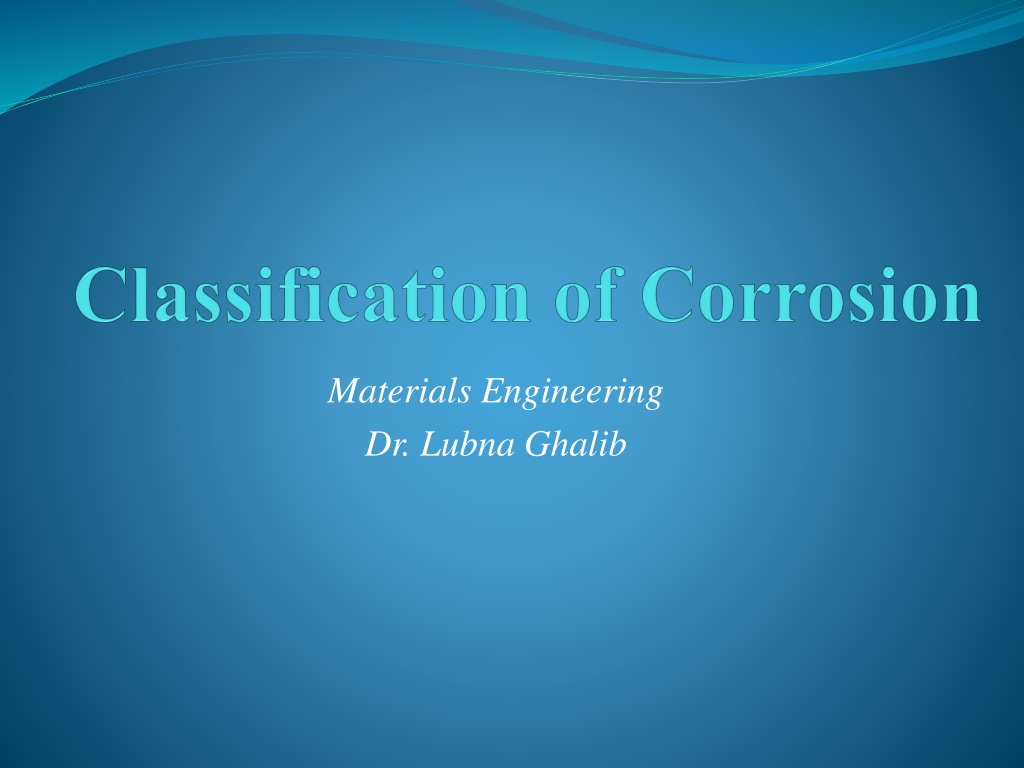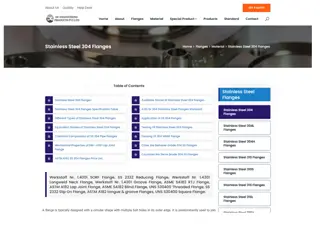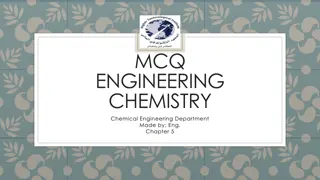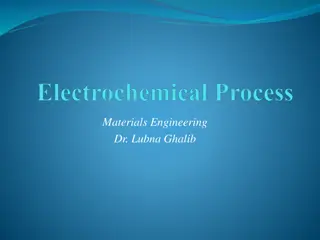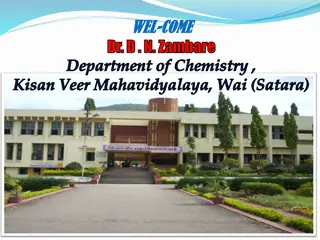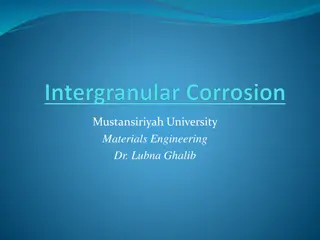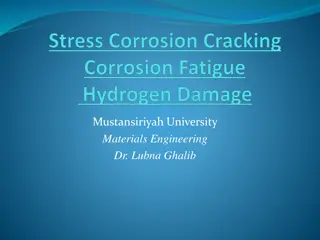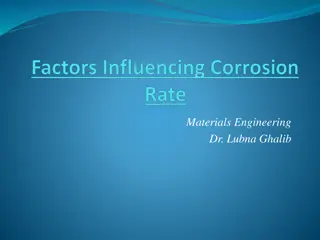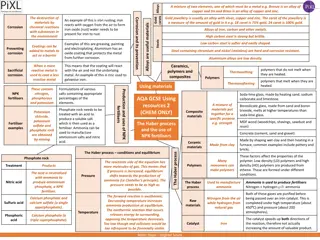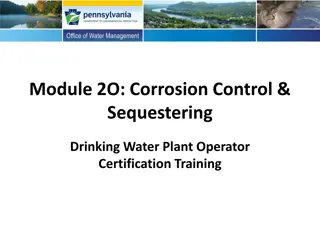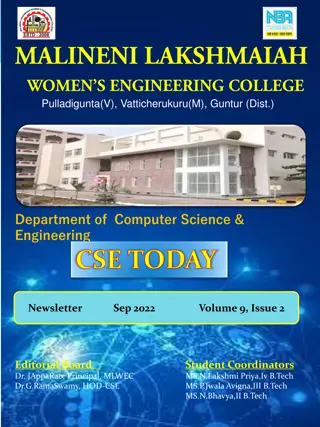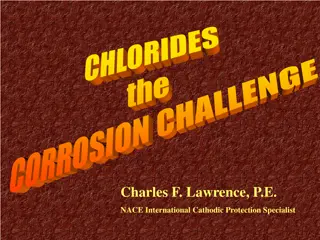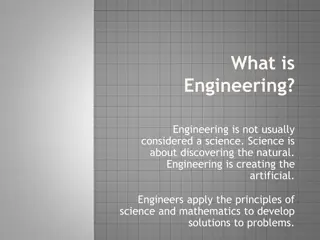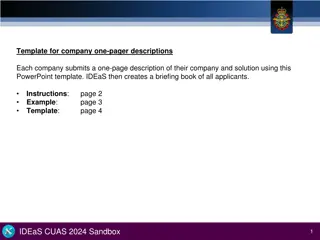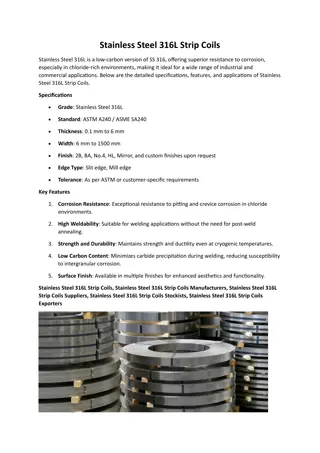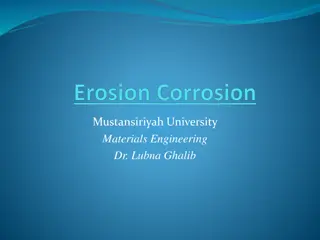Corrosion Science and Engineering Overview
Corrosion science and engineering encompass chemistry, materials science, and mechanics, focusing on understanding various corrosion mechanisms and protecting metal structures in different environments. Key challenges for corrosion scientists include developing new materials and surface treatments to enhance corrosion resistance.
Download Presentation

Please find below an Image/Link to download the presentation.
The content on the website is provided AS IS for your information and personal use only. It may not be sold, licensed, or shared on other websites without obtaining consent from the author.If you encounter any issues during the download, it is possible that the publisher has removed the file from their server.
You are allowed to download the files provided on this website for personal or commercial use, subject to the condition that they are used lawfully. All files are the property of their respective owners.
The content on the website is provided AS IS for your information and personal use only. It may not be sold, licensed, or shared on other websites without obtaining consent from the author.
E N D
Presentation Transcript
Materials Engineering Dr. Lubna Ghalib
Corrosion Science: Corrosion Science : is an interdisciplinary area embracing chemistry, materials science, and mechanics as shown in Figure 6. The study of aqueous corrosion processes involves the interaction of chemistry and materials science. But the science of mechanics must be added to understand mechanically assisted corrosion processes, such as stress-corrosion cracking and corrosion fatigue.
Corrosion Science: Figure 6: Distribution of disciplines in which active corrosion engineers have graduated
Corrosion Engineering: Corrosion Engineering is the application of science and art to prevent or control corrosion damage economically and safely. Corrosion Engineer is to protect corrosion of various metallic structures, e.g.: corrosion protection of Ships, Pipe Lines, Industries etc. Corrosion Engineering is supposed to have the knowledge of Metallurgy, Electro-Chemistry, Mechanical behaviors of Materials, Electrical Engineering, corrosion test, the nature of corrosive environments and the knowledge of Cost analysis.
What would be expected from Corrosion Scientist: Several important timely challenges to the corrosion scientist can be listed: 1. The development of protective surface treatments and corrosion inhibitors to replace inorganic chromates, which are environmentally objectionable. 2. An improved conservation of materials through the development of corrosion-resistant surface alloys which confine alloying elements to the surface rather than employing conventional bulk alloying.
What would be expected from Corrosion Scientist: 3. The formation of a new generation of stainless steels containing replacement for chromium and other critical metals. 4. An improved understanding of passivity so as to use our fundamental knowledge to guide the development of alloys having improved corrosion resistance. 5. Understanding the mechanism of the breakdown of passive oxide films by chloride ions and subsequence pitting of the underlying metal.
Corrosion Science Corrosion Engineering Basic scientific knowledge Corrosion mechanisms Accumulated scientific knowledge Corrosion protection Various metal systems + Specific conditions =Many different Various environments + case studies The ocean The atmosphere Industrial marine Soils Chemicals Geothermal brines The human body Pigeon excrement steel stainless steels Aluminum alloys Titanium alloys Copper alloys Nickel alloys Surface alloys Metallic coatings Organic coatings Concentration Temperature fluid flow stress Presence of O2 Absence of O2 pressure Organic inhibitors Biofilms
Classification of Corrosion: Corrosion may be classified in different ways Corrosion Wet Corrosion Dry Corrosion Corrosion Room Temperature Corrosion High Temperature Corrosion
Wet Corrosion: Wet / aqueous corrosion: is the major form of corrosion which occurs at or near room temperature and in the presence of water. This is usually involves aqueous solution or electrolytes and accounts for the greatest amount of corrosion by far. Wet Corrosion is a chemical reaction of a metal with the atmosphere in presencewater like: Fe + H2O No Corrosion Fe + H2O + Oxygen Fe (OH)2 Or Fe (OH)3 Chlorides may be wet Cl2 H2O + Cl2 HCl + HOCl
Dry Corrosion: Salts like NaCl , MgCl , CaCl2, .. etc. NaCl + H2O NaOH + HCl Corrosion by H2O + O2 at room temperature is about 1/20 to that of H2O + chlorides Dry/ gaseous corrosion is significant mainly at high temperatures and it occurs in absence of a liquid phase or an above the dew point of the environment. Vapors and gases are usually the corrodes. Dry corrosion is most often associated with high temperatures like: Oxidation of metals. Fe + O2 Fe2O3, Fe3O4, FeO
Wet & Dry Corrosion: Dry chlorine is practically non-corrosive to ordinary steel, but moist chlorine dissolved in water, is extremely corrosive and attacks most of common metals and alloys. The reverse is true for Titanium dry chlorine gas is more corrosive than wet chlorine. Sulfides H2S it is very highly corrosive substance. Dry forms Iron sulfide H2S Wet forms Oxy sulfides (H2S + H2O ) + hydrogen embittlements SO2: has no corrosion effect but in presence of moisture and oxygen forms sulfides
Differences between dry & wet corrosion: Wet corrosion Dry corrosion Corrosion occurs in presence of conducting medium. Corrosion occurs in the absence of moisture. It involves formation of electrochemical cells. It involves direct attack of chemicals on the metal surface. It is a rapid process The process is slow. Corrosion occurs at anode but rust is deposited at cathode. Corrosion products are produced at the site of corrosion It depends on the size of the anodic part of metal. The process of corrosion is uniform.
